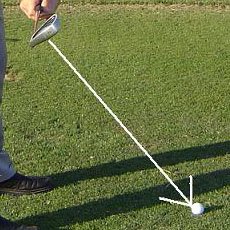How To Hit (use) Blade Irons

When wondering whether or not to make the switch from cavity backs to blades, the best thing to do is check the face of your cavity backs. If the center of your club face is worn from constant perfect hits, then blades might be the next step. If not, you can still make the switch, but you'll need to really examine your swing for the weak spots. If you twist or address the ball from an even slightly off center position, the odds are that using a blade iron will really highlight your flaws.
A common misconception when it comes to using blades is that a full backswing is an absolute must-have in order to hit on-target shots. That's not entirely true. While it's nearly always a fact that upon switching from cavity backs to blades, some loss of distance occurs, it's not necessary to use the full backswing. In fact, by doing so, you're more likely to miss the sweet spot and cost yourself even more distance. What matters most when it comes to consistent shots is what's comfortable for you. If you can't use a backswing to generate consistent, accurate shots, then stick with what you know. More than likely, you'll be spraying for a little while at first anyways, right after you make the switch. It's normal, but the more you practice, the better your swing will become.
Another thing to keep in mind with regards to your swing, is that blade irons are called muscle back irons for a reason. Unlike the perimeter weighting featured in cavity back clubs, in blades the weight is positioned directly behind the center of the club for extra power and feel, so you don't have to wind up like Fred Flintstone during your swing. Doing so will only make your shots more unstable.
Overall, when it comes to making the switch from cavity backs to blades, you need to develop your swing until it's completely flawless, and the only way to do that is to practice. It's not something you can learn from reading a manual. You just need to get out there on the course and give it a shot. Literally. Once you've done that, you'll be able to work the ball in ways cavity back irons simply can't do as well. And not only that, but after you've grown accustomed to blade irons, you'll be able to tell how and where you've hit the ball immediately upon contact, even if blindfolded. That's the kind of quality feel and feedback that blade irons provide, and it's something cavity back irons still aren't able to measure up to.
Related Guides
What Are Blade Irons?
Why Use Blade Irons
Blade Irons Vs Cavity Back Irons
The Blade Iron Set - A Look Inside
Left Handed Blade Irons - A Look At The Market
History Of The Blade / Tour Iron
Blade Iron Reviews